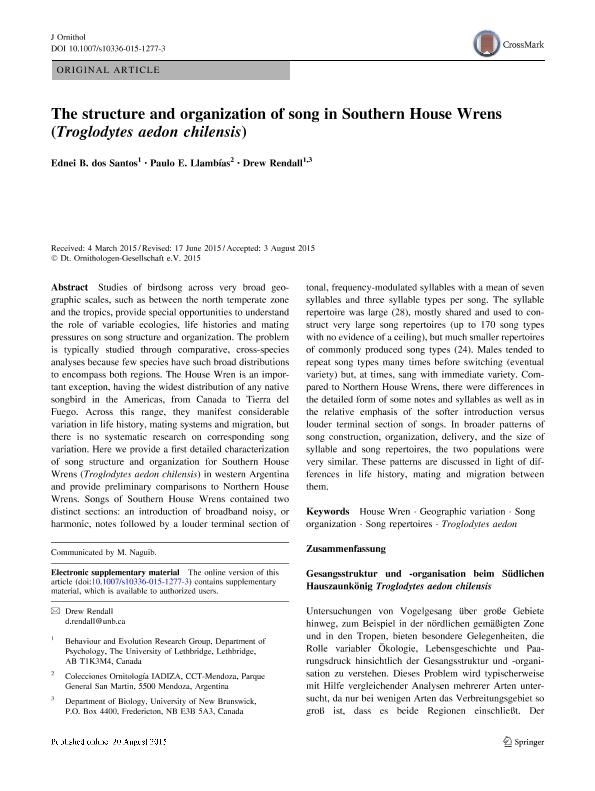Mostrar el registro sencillo del ítem
dc.contributor.author
dos Santos, Ednei B
dc.contributor.author
Llambias, Paulo

dc.contributor.author
Rendall, Drew
dc.date.available
2018-05-22T20:58:12Z
dc.date.issued
2015-08
dc.identifier.citation
dos Santos, Ednei B; Llambias, Paulo; Rendall, Drew; The structure and organization of song in Southern House Wrens (Troglodytes aedon chilensis); Springer; Journal of Ornithology; 157; 1; 8-2015; 289-301
dc.identifier.issn
1519-888X
dc.identifier.uri
http://hdl.handle.net/11336/45955
dc.description.abstract
Studies of birdsong across very broad geographic scales, such as between the north temperate zone and the tropics, provide special opportunities to understand the role of variable ecologies, life-histories and mating pressures on song structure and organization. The problem is typically studied through comparative, cross-species analyses because few species have such broad distributions to encompass both regions. The House Wren is an important exception,having the widest distribution of any native songbird in the Americas, from Canada to Tierra del Fuego. Across this range, they manifest considerable variation in life-history, mating systems and migration, but there is no systematic research on corresponding song variation. Here we provide a first detailed characterization of song structure and organization for Southern House Wrens (T. aedon chilensis) in western Argentina, and provide preliminary comparisons to Northern House Wrens. Songs of Southern House Wrens contained two distinct sections: an Introduction of broadband noisy, or harmonic, notes followed by a louder Terminal section of tonal, frequency13 modulated syllables with a mean of 7 syllables and three syllable types per song. The syllable repertoire was large (28), mostly shared, and used to construct very large song repertoires (up to 170 song types with no evidence of a ceiling), but much smaller repertoires of commonly produced song types (24). Males tended to repeat song types many times before switching (eventual variety) but, at times, sang with immediate variety. Compared to Northern House Wrens, there were differences in the detailed form of some notes and syllables as well as in the relative emphasis of the softer Introduction versus louder Terminal section of songs. In broader patterns of song construction, organization, delivery, and the size of syllable and song repertoires the two populations were very similar. These patterns are discussed in light of differences in life history, mating and migration between them.
dc.format
application/pdf
dc.language.iso
eng
dc.publisher
Springer

dc.rights
info:eu-repo/semantics/openAccess
dc.rights.uri
https://creativecommons.org/licenses/by-nc-sa/2.5/ar/
dc.subject
House Wren
dc.subject
Geographic Variation
dc.subject
Song Organization
dc.subject
Song Repertoires
dc.subject
Trolodytes Aedon
dc.subject.classification
Otras Ciencias Biológicas

dc.subject.classification
Ciencias Biológicas

dc.subject.classification
CIENCIAS NATURALES Y EXACTAS

dc.title
The structure and organization of song in Southern House Wrens (Troglodytes aedon chilensis)
dc.type
info:eu-repo/semantics/article
dc.type
info:ar-repo/semantics/artículo
dc.type
info:eu-repo/semantics/publishedVersion
dc.date.updated
2018-04-24T14:55:07Z
dc.journal.volume
157
dc.journal.number
1
dc.journal.pagination
289-301
dc.journal.pais
Reino Unido

dc.journal.ciudad
Londres
dc.description.fil
Fil: dos Santos, Ednei B. University Of Lethbridge; Canadá
dc.description.fil
Fil: Llambias, Paulo. Consejo Nacional de Investigaciones Científicas y Técnicas. Centro Científico Tecnológico Conicet - Mendoza. Instituto Argentino de Investigaciones de las Zonas Áridas. Provincia de Mendoza. Instituto Argentino de Investigaciones de las Zonas Áridas. Universidad Nacional de Cuyo. Instituto Argentino de Investigaciones de las Zonas Áridas; Argentina
dc.description.fil
Fil: Rendall, Drew. University of New Brunswick; Canadá
dc.journal.title
Journal of Ornithology

dc.relation.alternativeid
info:eu-repo/semantics/altIdentifier/doi/https://doi.org/10.1007/s10336-015-1277-3
dc.relation.alternativeid
info:eu-repo/semantics/altIdentifier/url/https://link.springer.com/article/10.1007%2Fs10336-015-1277-3
Archivos asociados
